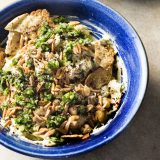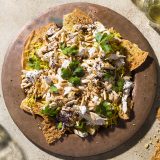There are constants across the culinary world. Our cultures and cooking and ingredients may vary by continent, country, region, even neighborhood and house-to-house, but the fingerprints of certain foods show up nearly everywhere. The table of contents for our communal kitchen is writ large; the fine print is where we introduce delicious nuance.
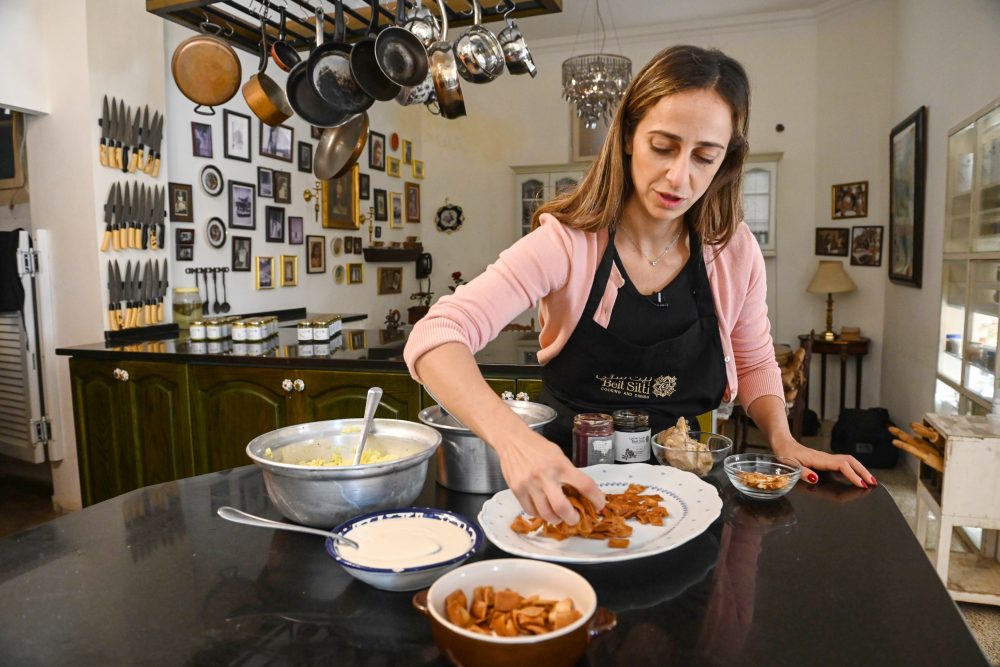
Maria Haddad demonstrated that almost anything can be combined for fatteh.
It’s almost as though it is baked into humanity’s DNA that we all should have some sort of flatbread, whether it’s a corn tortilla, a wheat pita or a rice roti. Or a meatball, whether a South African frikkadel, a Chinese shi zi tou or a Middle Eastern köfte. Don’t even get me started on the diaspora of chicken soup.
And then there are the multitude of ways we’ve all learned to repurpose stale bread. It might be sautéed with chorizo for Spanish migas, crisped and tossed with tomatoes for Italian panzanella. Or crumbled and toasted for an all-American meatloaf (itself a dish with endless global iterations). It could even be tortillas torn into a simple soup in Mexico.
And across the Arab world, there is fatteh, a family of dishes whose name translates as—no surprise here—broken bread. And that’s one of the many reasons I found myself sitting at the kitchen counter of Maria Haddad’s grandmother’s home, a sprawling and airy hilltop home in one of the oldest neighborhoods of Amman, Jordan.
I’d tasted fatteh—traditionally toasted and crumbled pita bread layered with tahini, yogurt, nuts and a what-have-you possibility of ingredients, from roasted eggplant to hummus to chicken to lentils, then eaten by spoon or scooped into fresh pita—at a variety of restaurants famous for it across the city. To be honest, I wasn’t impressed.
I’ll eat just about anything doused with tahini. But the dishes I was served verged on porridge, lacking texture or distinct flavors. Turns out, that’s because restaurants mostly have modernized their fatteh, replacing the toasted pita with spongy Western-style buns—think Wonder Bread consistency—and mashing everything together rather than layering.
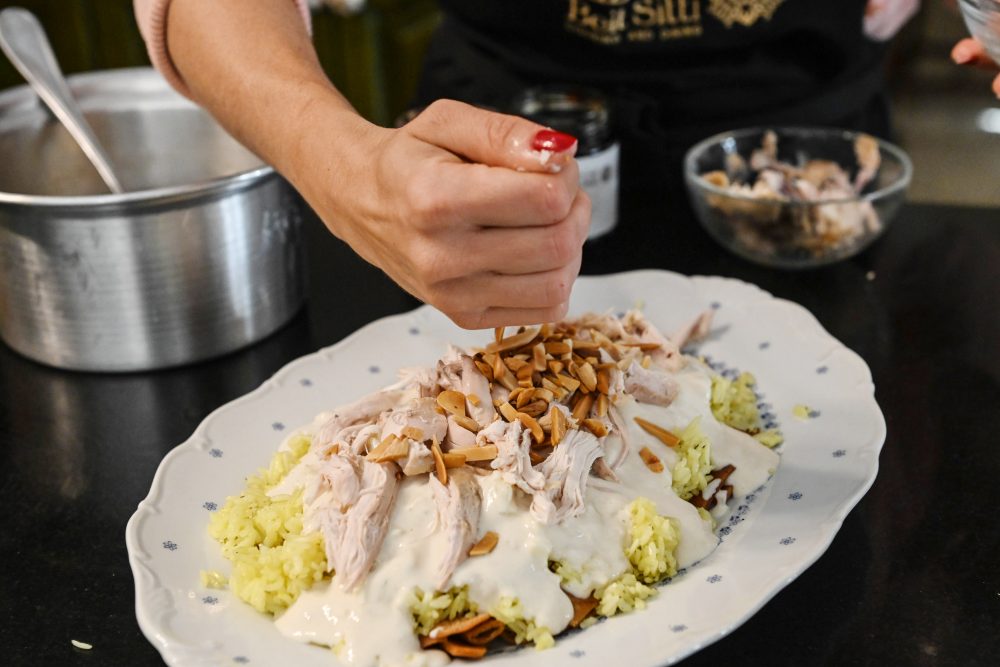
No amount of tahini was going to help me sell the appeal of this. When I expressed my reservation to Haddad, she agreed but said I shouldn’t judge fatteh until I’d had it the real way. That is, made with crispy shards of oiled and toasted pita bread, then layered—not smooshed—with other ingredients, creating a delicious strata of tastes and textures.
Haddad’s childhood was spent cooking and learning Jordanian classics at her grandmother’s side. In 2014, she and her sisters converted the home into the Beit Sitti cooking school, employing local women to continue the tradition of passing along cherished recipes. She offered to teach me fatteh dajaj, or chicken fatteh.
“There’s so many levels to this dish, that’s why it’s so good,” she said, noting that it’s particularly popular at the start of the new year, when tradition holds that the first thing cooked should be white. “It also is good for hangovers!”
She began by toasting whole spices—a cinnamon stick, green cardamom pods and whole cloves—in olive oil. After several minutes, she added a skinless chicken breast, browning it lightly all over. Water went next, gently poaching the meat. It was a simple step that would come to flavor the fatteh in multiple ways.
While the chicken cooked, she prepared white rice, soaking it briefly, then adding water and what she called Jordanian umami, a spice blend of onion and garlic powders, fennel, rosemary, coriander, mint, saffron, turmeric and salt. Also, the tahini sauce, a blend of yogurt, lemon juice and sesame paste. Jordan’s holy trinity, Haddad called it.
Meanwhile, day-old pita bread was oiled and baked until crisp and lightly browned. Once cooled, it easily shattered into irregular chunks. Tradition calls for frying the bread, but Haddad prefers to bake it, favoring the ease and lighter flavor.
It was time to assemble our fatteh. She began with a layer of pita chips on a wide platter. To flavor and soften the pita—though just in parts, and not enough to make it soggy—she drizzled over the pieces some of the liquid left from poaching the chicken. An even layer of richly aromatic rice came next. Then the tahini sauce, tangy with yogurt and lemon.
The still-warm chicken shredded easily off the bone, and Haddad spread this evenly over the sauce. Finally, she sprinkled on toasted almonds—“Arabic food has to be topped with toasted almonds. Nothing is complete without them.”—as well as chopped fresh parsley, tangy sumac and a drizzle of pomegranate molasses.
When I tasted it—first by the spoonful, later mounded into fresh pita, then more just spooning it because I was able to get it into my mouth faster—it was shocking. Nothing, truly nothing, like any fatteh I’d had so far. It was at once creamy and crunchy, rich and tangy, savory and warm, but also cool and sweet. There were distinct layers that complemented one another, rather than wash each other out. It hit every note in every way that makes you want more. And more.
Over the period of another week eating my way around Amman, I tried many more variations of fatteh. But only those made by home cooks. And they never disappointed. Rawan Mohamad Abuead introduced me to an amazing hummus fatteh, in which chickpeas whole and pureed married crisp pita, tahini sauce, fresh chilies and ghee-toasted almonds.
Mayson Burjaq taught me her mother’s fatteh batenjan, or eggplant fatteh. This time the pita was topped with chunks of lightly fried eggplant tossed with crushed tomatoes and garlic, then layers of tahini sauce, spiced ground beef, deep-fried almonds and finally a blanket of chopped fresh herbs. Outrageously savory and sweet, creamy and crunchy, spicy and cool.
Lesson learned. Food is our commonality. If we let it, it can unite us, teach us how we all really are so very similar. How we want so much of the same. But its true wonder is how it simultaneously differentiates us.
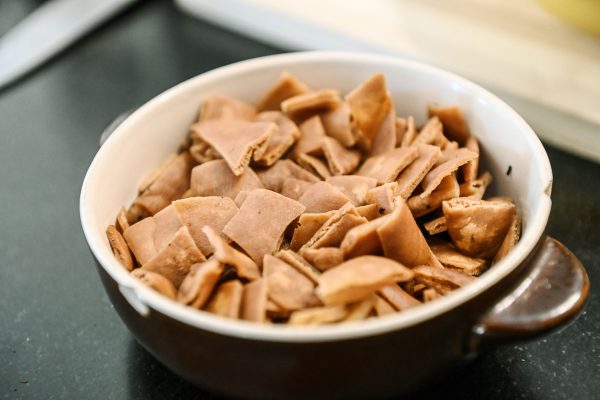
Crisped hunks of pita form the crunchy base of every version of fatteh.
Over the period of another week eating my way around Amman, I tried many more variations of fatteh. But only those made by home cooks. And they never disappointed. Rawan Mohamad Abuead introduced me to an amazing hummus fatteh, in which chickpeas whole and pureed married crisp pita, tahini sauce, fresh chilies and ghee-toasted almonds.
Mayson Burjaq taught me her mother’s fatteh batenjan, or eggplant fatteh. This time the pita was topped with chunks of lightly fried eggplant tossed with crushed tomatoes and garlic, then layers of tahini sauce, spiced ground beef, deep-fried almonds and finally a blanket of chopped fresh herbs. Outrageously savory and sweet, creamy and crunchy, spicy and cool.
Lesson learned. Food is our commonality. If we let it, it can unite us, teach us how we all really are so very similar. How we want so much of the same. But its true wonder is how it simultaneously differentiates us.
Related Recipes
May - June 2023

Sign up to receive texts
Successfully signed up to receive texts!
We'll only send our very best offers - Like a $15 store credit to start.
By entering your phone number and submitting this form, you consent to receive marketing text messages (such as promotion codes and cart reminders) from Christopher Kimball's Milk Street at the number provided, including messages sent by autodialer. Consent is not a condition of any purchase. Message and data rates may apply. Message frequency varies. You can unsubscribe at any time by replying STOP or clicking the unsubscribe link (where available) in one of our messages. View our Privacy Policy and Terms of Service.
